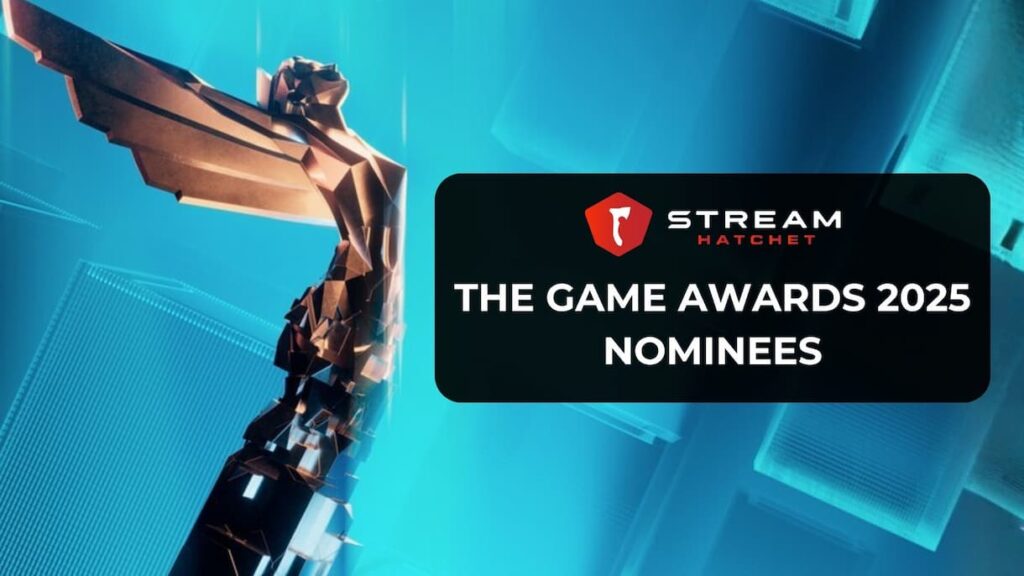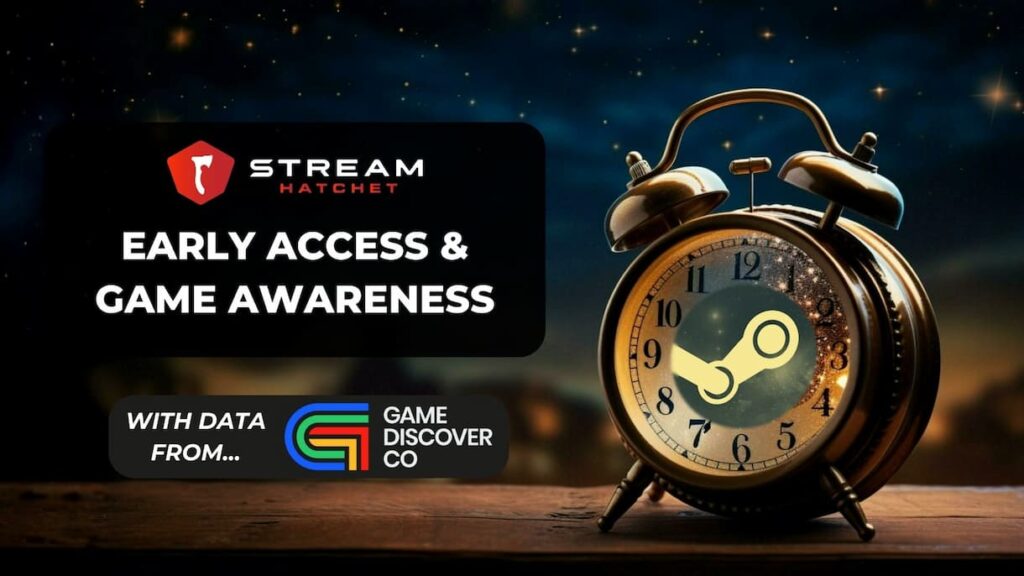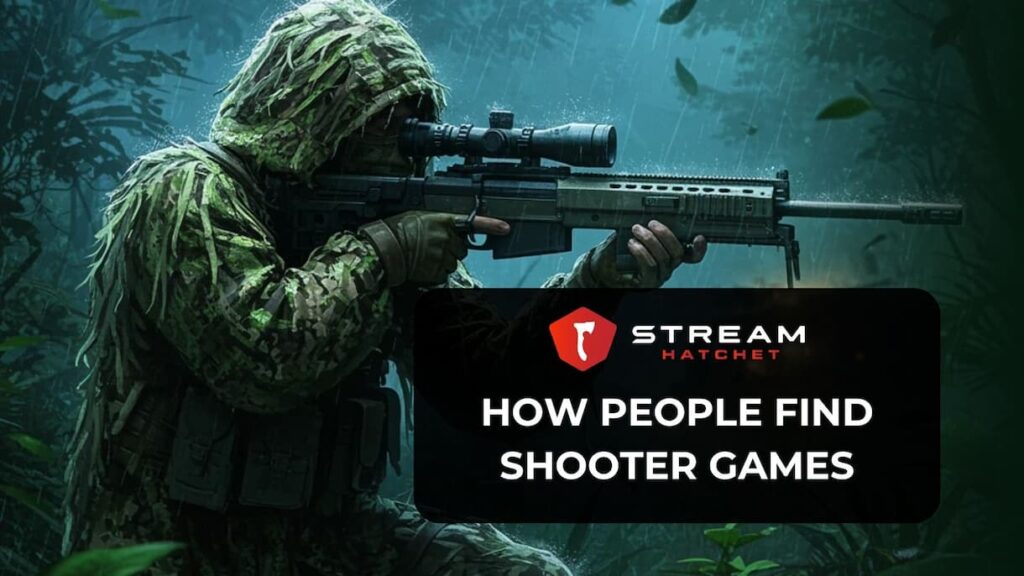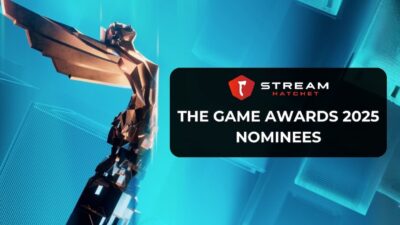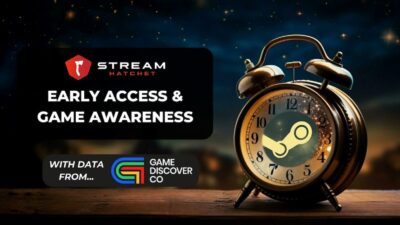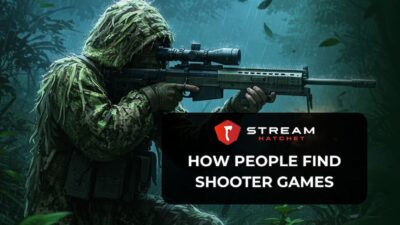Although games have had some form of DLC since right back with the Atari 2600, the term DLC only became widely popularized in the mid-to-late 2000s as consoles competed to prove their dominance with online compatibility. Since then, the term DLC has become polarizing, with detractors claiming that most DLC is an excuse to initially ship an unfinished product while supporters love how DLC can expand their favorite game worlds.
One undeniable fact is that DLC increases a game’s longevity, allowing games to stay relevant long after release on live-streaming platforms. The content of this DLC can vary wildly: Although we typically think of DLC as full-on expansions (new missions, levels, storylines), many of the top-rated DLC on Steam are simple cosmetic packs or soundtracks. For game developers choosing between spending their time on a new game or supporting their old titles with DLC, it would be helpful to know how much effort DLC is worth in terms of visibility on live streaming.
In this article, we look at the recent success of Diablo IV’s Vessel of Hatred DLC, and then take a deep dive into viewership growth for some of the most commercially successful DLC of the past several years.
Diablo 4’s Content Mill Keeps Players and Viewers Coming Back
Diablo IV’s Vessel of Hatred DLC was a phenomenal success on live streaming, generating 7.8M hours watched in its first 3 days of release. DLC is an interesting scenario with the Diabl series. Since Diablo III, the series has been live service: The games have featured seasons where major updates are made and character progress sometimes resets (depending on play preference). Like other live service games (Fortnite, Apex Legends), these new season moments provide incentive for players who have lost connection with Diablo IV to jump back into the fray. Clearly the strategy is effective, with Season 4 (Loot Reborn) seeing 5.6M hours watched in its opening week.
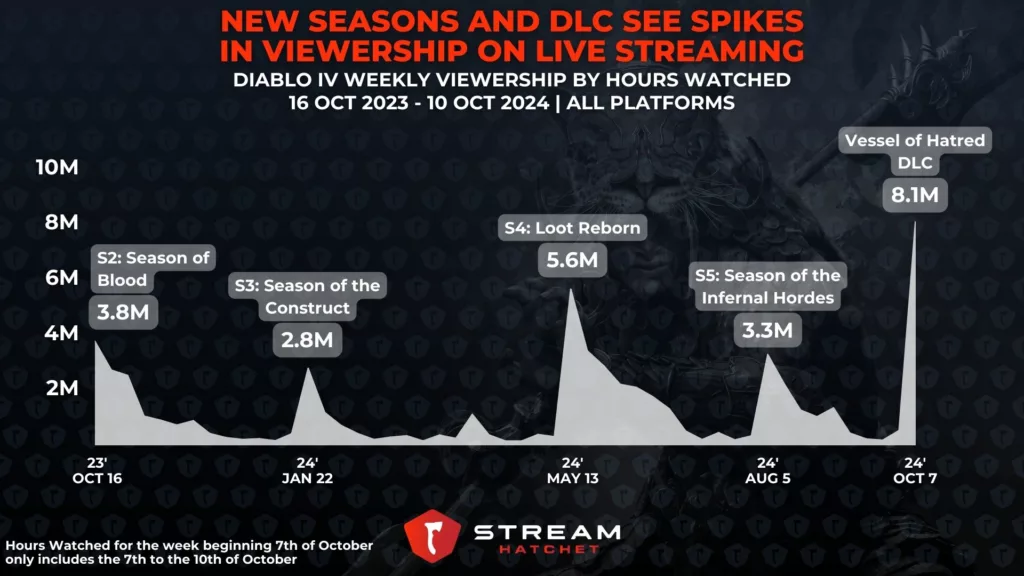
But DLC as a promotional term proved more powerful in bringing players back than just a new season (based on the gap in viewership). To demarcate Vessel of Hatred from ‘just another new season’, Blizzard released a beautifully realized new trailer (which recalls the hype for the original Diablo IV Lilith reveal trailer). Blizzard also traded on the goodwill of its series’ heritage, with Diablo featuring some of the best-loved DLC releases of all time (Diablo 2’s Lord of Destruction and Diablo 3’s Reaper of Souls).
As another example of the potential impact of wording, note that “Loot Reborn” got more viewership than any of the “Season of…” titles for new seasons. This could be due to Loot Reborn addressing the glut of unnecessary equipment in the game, but it may also catch players’ attention and prompt online queries for better understanding.
DLC Roughly Quintuples Live Streaming Viewership on Average
We’ve covered many DLC releases before, highlighting their effectiveness at boosting live-streaming viewership. But how effective are they really? To get a better idea, we looked at a sample of 75 best-selling DLC packages from the past several years. The only constraint was that these DLCs had to have significant amounts of new content such as new classes, levels, and stories (rather than only new weapons, costumes or music).

Comparing DLC debut week viewership to viewership from the week prior to DLC dropping revealed an average jump in weekly viewership of 387% – a nearly quintuple increase in hours watched! However, a few standout titles dragged this average up, including Outward: The Three Brothers (3,835%), God of War Ragnarök: Valhalla (3,235%), and Fallout 76: Wastelanders (1,282%). Given these highly skewed titles, it might be more accurate to report a median increase in viewership from DLC of 179% – still a massive triple-up in viewership from DLC release! More Games in this region include Destiny 2: The Final Shape (412%), Horizon Forbidden West: Burning Shores (190%), and Monster Hunter World: Iceborne (168%).
Of course, DLC doesn’t guarantee a bump in viewership. A few titles actually saw lower viewership following the release of their DLC, suggesting that the DLC was perhaps not marketed well or that gamers weren’t enjoying the base game, and therefore didn’t want more content. After all, DLC still costs money and with so many options, new content just isn’t a guarantee of sufficient interest. The lower-performing DLC packages included Dying Light 2 Stay Human: Bloody Ties (-24%) and Monster Hunter Stories 2: Wings of Ruin (-42%).
DLC’s Impact in Comparison to New Game Launches, and the Long-Tail Effect
Of course, if DLCs only provide a temporary boost to viewership which quickly trails off, the effort for developers may not be worth it. To get a clearer picture of just how worthwhile DLC can be, it’s worth comparing the DLC release viewership to the original game’s release viewership for 50 best-selling DLC packages. Note that these 50 games were also in the analysis above (with 25 games being removed due to a lack of original release week viewership data).
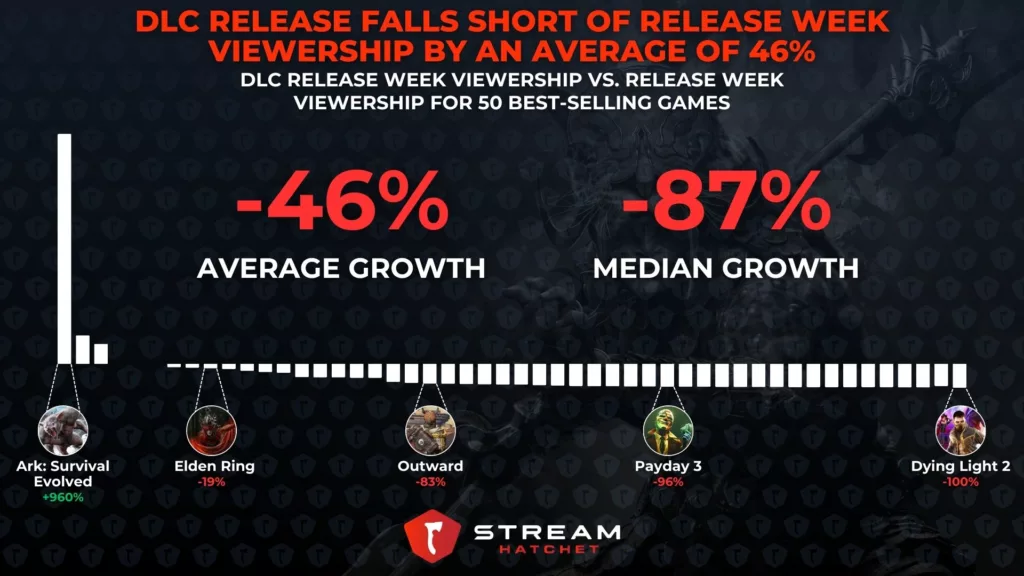
As might be expected, DLC release isn’t able to match up to the original game’s full release in most cases, with an average drop in viewership of 46%. Again though, this figure is massively skewed by one title in particular: ARK: Survival Evolved – Genesis Part I with a massive growth of 960%. This game bucked the trend of most other titles due to Ark: Survival Evolved not performing as well upon initial release with only 399K hours watched in its debut week. Given this outlier, it might again be more accurate to use the median drop in viewership of 87% – indicating a DLC week release viewership is only roughly one-tenth of the original release viewership. Games in this region include Hollow Knight: The Grimm Troupe (-86%), Horizon Zero Dawn: The Frozen Wilds (-90%), and DOOM Eternal: The Ancient Gods – Part One (-84%).
Viewed this way, any game that achieves half or more of its original release viewership can be considered a success on live streaming. A chief example would be Elden Ring: Shadow of the Erdtree which only dropped 19% from the game’s original release. This incredible performance is a result of Elden Ring’s popularity, the rarity of new content for the title, and massive hype among streamers such as Kai Cenat’s marathon Elden Ring streams. For single-player titles, this kind of bump is crucial: It means that DLC can greatly extend the shelf-life and attach rates for a game. As noted by Simon Carless for GameDiscoverCo, DLC can also give players who missed the original release a chance to join the community – and live streaming is all about nurturing community.
DLC isn’t just about release hype then, but about increasing the longevity of a game on live streaming. Obviously not every game can be a massive AAA title with a wealth of new content support, but even medium-sized publishers can adopt some of the lessons seen here. Stream Hatchet will watch to see more marketing campaigns around DLC releases in the future.
To keep up to date with the latest popular games on live-streaming platforms, follow Stream Hatchet:

